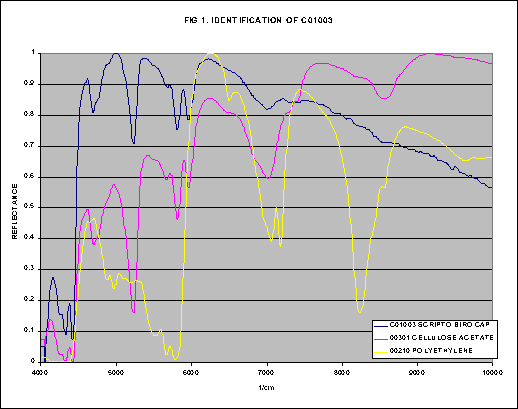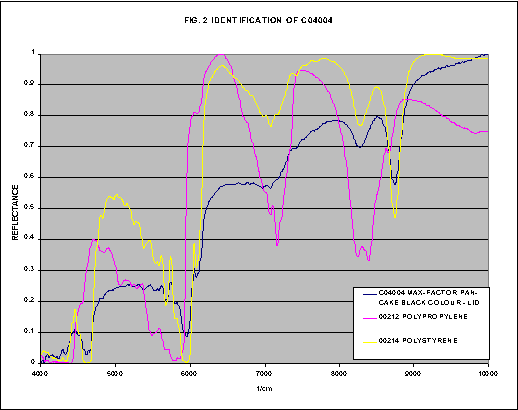by John Edwards, Edwards Analytical
Established in 1987 Edwards’ Analytical is an independent consultancy for the analysis and evaluation of plastics, rubbers and packaging materials, particularly for the pharmaceutical, health care and food industries. Its major activity is in measuring and predicting plastic packaging / packaged product / environment interactions.
After graduating from Bradford University’s School of Archaeological Science, J.H.Edwards joined the company as a partner. Using his specialised knowledge and the related techniques already in use at Edwards’ Analytical, Edwards’ Analytical now provides a service for the identification of archaeological materials and historical objects.
Many museums house collections of “modern” objects from the late 19th and 20th century, of which a high proportion are made of plastic. But, contrary to common belief, plastics, especially the early plastics, do degrade over time. Therefore the accurate identification of plastics is essential to the assessment of storage environments for the artefacts and in predicting their rate of deterioration. Items that give off breakdown products harmful to other materials need to be isolated (e.g. cellulose nitrate and acetate). As each material has its specific conservation requirements, only by positive identification of the polymers can conservation techniques be recommended.
At present there are traditional techniques available such as FT-IR, FT-IR/microscopy, FT-Raman and Differential Scanning Calorimetry. However all are inherently destructive by the virtue that a sample is required from the object to be tested, this also requires either the object or the sample to be removed from the museum back to the testing laboratory. Edwards’ Analytical with the aid of Keith Longdon of Buchi Analytical Ltd identified that these problems (non-destructive and in-situ testing) are solved with the employment of the Buchi FT-NIR and fibre optic reflectance probe.
Where FT-NIR, cannot identify particular materials, the items can still be brought back for identification in-house by the above traditional techniques.
Since there is no existing database of historical plastics in the NIR, to set up the identification service a data base was constructed in two parts:
- Polymers were purchased from the Aldrich Chemical Company and their NIR spectra recorded.
- With the exclusive cooperation of Colin Williamson of Smile Plastics, historical plastic objects with known provenance and identification were analysed.
Using the two databases Edwards’ Analytical was invited by Yannick Minvielle-Debat from Bradford Conservation & Research, University of Bradford to conduct an identification survey of the Hammer Horror collection recently acquired by the National Museum of Photography, Film & Television, Bradford, dating from the late 1950’s – 1970’s.
Yannick describes the collection to consist of a large number of artefacts all relating to make-up and special effects work. The collection belonged to the two make-up artists who worked for the Hammer Films, Phil Leakey and latterly Roy Ashton, and it is of special significance as it reflects the pioneering nature of early special effect make-up work.
The unique character of this modern collection comes from the fact that a large proportion of it was not readily identifiable. Indeed, nearly 30% of the artefacts were described as ‘plastic’, a generic term representing a large variety of polymers. Because of the low budget available for the production of the Hammer movies, many of the special effects props (bite marks, vampire teeth etc.) were hand made with various kinds of readily available materials but unidentifiable at first sight. Preliminary visual identification of a selected number of plastic objects was made by two members of the Plastics Historical Society who came to visit the collection in June 2000, however it was not until September 2002 that Edwards Analytical visited and began to survey this collection using the NIR that over 80 objects have been analysed and identified.
An example of the success of this survey can be demonstrated in the examples below:
| NIR CODE | OBJECT | DESCRIPTION OF OBJECT | VISUAL IDENTIFICAITON | NIR IDENTIFICATION |
|---|---|---|---|---|
| C01003 | Scripto Biro cap | Gold pigment
Opaque |
Cellulose Acetate | Cellulose Acetate |
| C04022 | “Max Factor” Pan-Stick | White pigment | Polypropylene | Polystyrene |
| NIR CODE | C01003 |
| OBJECT | Script Biro cap |
| DESCRIPTION OF OBJECT | Gold pigment Opaque |
| VISUAL IDENTIFICATION | Cellulose Acetate |
| NIR IDENTIFICATION | Cellulose Acetate |
| NIR CODE | C04022 |
| OBJECT | “Max Factor” Pan-Stick |
| DESCRIPTION OF OBJECT | White Pigment |
| VISUAL IDENTIFICATION | Polypropylene |
| NIR IDENTIFICATION | Polystyrene |
As can be seen in Fig. 1, by correlating the sample (C01003) composed of an unknown material with the database we have identified it to be most likely Cellulose Acetate. A possible alternative material included for comparison in Fig. 1 is polyethylene which is a replacement to cellulose acetate in modern pen caps, though is conclusively an unlikely material in this object.

During the survey of the Hammer Collection we have found some positive identification of materials which have not correlated with the preliminary visual identification. An example of this can be seen with object C04022 – a “Max Factor” Pan-Stick. This has been identified as most likely to be polypropylene, however when we compared the object to our reference database we discovered no similarity in the spectra. Indeed after processing the spectra as can be seen in Fig. 2 it has been concluded that the closest mach of this object is polystyrene.

In conclusion after the setting up of our database of identified materials, Edwards’ Analytical is now confident in its employment of the Buchi FT-NIR for the non-destructive analysis of materials made from synthetic and natural polymers.
© Edwards Analytical, January 2003

